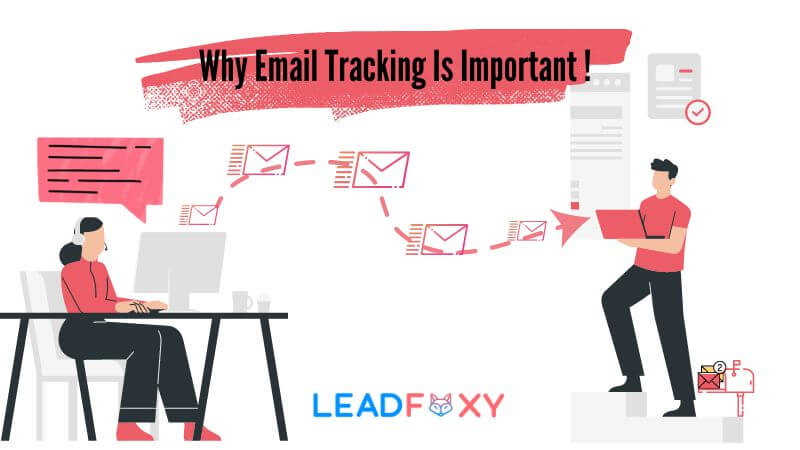Email tracking can be helpful if you want to track how many people or leads are opening your emails and on what devices. To track your email, simply click on the sent folder and hover over the checkmark icon. As well as knowing how many emails have been sent, you can also see where those emails have been opened and on what devices. This information can be helpful if you’re trying to gauge the effectiveness of your communications.
Email tracking can be a helpful tool for keeping tabs on your messages and making sure they’re being seen by your intended recipients.
![]()
What is email tracking and how does it work?
Email tracking is a technique employed to oversee the delivery of email correspondences to their designated recipients. It involves employing software to collect data about a person’s email habits, including when the emails were opened, where they were opened, the device used to open them, how much time was spent reading the email, and whether any links or attachments in the email were clicked or downloaded. This information is incredibly valuable for businesses, particularly in marketing and sales efforts, customer service interactions, and more.
Here is how email tracking works:
- Tracking Software or Scripts: Email tracking involves the use of specific software or scripts integrated into the email content. When an email is sent, this software adds an invisible image or pixel within the email, which notifies the sender when the email is opened by the recipient.
- Data Tracking: When the recipient accesses the email, the embedded tracking pixel triggers a response that is sent back to the originating server or service that implemented the pixel, thereby signaling that the email has been successfully opened.The tracking pixel may also collect and transmit other data such as the IP address, geographical location, device type, or time spent viewing the email.
- Link Tracking: Similarly, links within the email can be customized to allow tracking when they are clicked. This can be done by redirecting the link click through a tracking server before going to the final destination or by adding a code to the URL that reports back when the link is used.
- Reporting: The tracking software records and analyzes these signals in real-time, then reports the data back to the sender. Often, this information is organized into an analytics dashboard that shows detailed behavior patterns, such as open rates, click through rates, and more.
The ethical and privacy aspects of email tracking are a topic of ongoing debate. Some users may see it as an invasion of privacy, especially if done without their consent. Many business professionals ensure transparency by notifying customers or recipients that tracking is being utilized, often through privacy policies or terms of use. Many email clients now offer the option to block the downloading of images/pixels to help protect their users’ privacy.
Important of email tracking for B2B Business
Email tracking is important for B2B businesses because it allows businesses to see how often their emails are being opened and read. This information can be used to gauge interest in a product or service, and can also help businesses to determine when is the best time to send emails. Additionally, email tracking can help businesses to avoid sending too many emails, which can result in customers feeling overwhelmed or annoyed.
Overall, email tracking is a helpful tool that can lead to increased conversions and sales. By understanding how your subscribers interact with your emails, you can make necessary changes to improve results. This, in turn, will lead to a higher ROI for your business.
The benefits of email tracking: Increased deliverability, insights, and more
This practice can be beneficial for both businesses and consumers. By understanding how email tracking works, companies can develop more targeted marketing campaigns and consumers can be more informed about the products and services they are interested in. Here are three benefits of email tracking:
- Increased deliverability: By tracking your emails, you can see which ones are getting delivered and which ones are getting bounced back. This way, you can make sure that your messages are getting through to your recipients.
- Insights: Tracking also provides valuable insights into your recipients’ behavior. You can see when they open your emails, what links they click on, and how often they engage with your messages. This information can help you fine-tune your marketing strategies.
- More efficient communications: With email tracking, you no longer have to wonder whether or not your recipient received your message. If you see that an email was opened, you know it was successful.
The drawbacks of email tracking: Privacy concerns, extra steps, and more
Email tracking can be a great way to keep tabs on your messages and make sure they’re being read. However, there are some drawbacks to using this feature that you should be aware of.
- Email tracking can invade your recipients’ privacy. If they didn’t know you were doing it, they may feel like you’re spying on them. This could damage your relationship with them.
- Another downside is that it takes extra steps to set up email tracking. You have to add a special code to your messages or use a third-party service. This can be a hassle, especially if you send a lot of emails.
- Email tracking doesn’t always work the way you want it to. The message may not be opened at all, or the recipient may delete it before reading it.
![]()
How to set up email tracking
Email tracking is a great way to keep tabs on your important messages and make sure they are being read. Here are some tips on how to set up email tracking:
Email tracking can seem like a daunting task, but it doesn’t have to be! This step-by-step guide will show you how to set up email tracking in no time.
First, you’ll need to create an account with an email tracking service. We recommend using MailTrack.io, as it’s free and easy to use.
Once you’ve created your account, you’ll need to add a few lines of code to your email signature. This will allow the tracking service to track your emails and see when they’re opened.
That’s it! Once you’ve added the code to your signature, you’re all set up and ready to start tracking your emails. You’ll be able to see when each email is opened, how many times it’s been opened, and where in the world it was opened.
How to use email tracking effectively
Email tracking is a great way to keep tabs on your email marketing campaign’s performance. By tracking who opens your emails and when you can gauge interest levels and adjust your strategy accordingly.
To use email tracking effectively, start by choosing a reputable email tracking service. Once you’ve set up an account, simply add a tracking code to your email’s HTML code before sending it out. When recipients open the email, the code will activate and record the event in the service’s database.
You can then log into your account to view comprehensive reports on your campaign’s progress. These reports will show you how many people opened your email, when they did it, and which links they clicked on. Armed with this information, you can fine-tune your approach to ensure maximum engagement with your target audience.
FAQs
[saswp_tiny_multiple_faq headline-0=”h3″ question-0=”What email tracking services are available?” answer-0=”There are many email tracking services available that can help you keep track of your email communications. Some of these services include MailTrack, HubSpot Sales, Yesware, and Streak. These services can help you see when your emails are opened, how long they are read for, and whether or not the recipient clicks on any links within the email. This information can be very valuable in terms of understanding how your recipients interact with your emails and determining what types of messages are most effective.” image-0=”” headline-1=”h3″ question-1=”Does Gmail have email tracking?” answer-1=”Gmail offers email tracking as a way to view when and where your emails are being opened. This can be a helpful tool for keeping track of important messages or conversations. However, it is important to remember that this feature can also be used to invade someone’s privacy, so it should be used with caution.” image-1=”” headline-2=”h3″ question-2=”Is tracking email illegal?” answer-2=”Email tracking is not illegal. Email marketers and businesses use it as a way to measure the effectiveness of their campaigns and to make sure that their customers are happy with the product or service. However, some people do view it as an invasion of privacy. If you are concerned about your privacy, you can always unsubscribe from emails or use a different email address when signing up for newsletters or making online purchases.” image-2=”” count=”3″ html=”true”]
Conclusion
Email tracking can be a helpful tool in a variety of situations. It can help you keep track of important correspondence, make sure your messages are being read, and track your own productivity. Email tracking can also be used to monitor employee email usage and prevent data leaks. However, it is important to use email tracking responsibly and respect the privacy of others.




